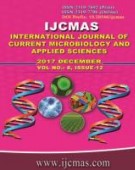


 National Academy of Agricultural Sciences (NAAS)
National Academy of Agricultural Sciences (NAAS)

|
PRINT ISSN : 2319-7692
Online ISSN : 2319-7706 Issues : 12 per year Publisher : Excellent Publishers Email : editorijcmas@gmail.com / submit@ijcmas.com Editor-in-chief: Dr.M.Prakash Index Copernicus ICV 2018: 95.39 NAAS RATING 2020: 5.38 |
The experiment was conducted under green house in the Department of Soil Science and Agricultural Chemistry, University of Agriculture, G.K.V.K., Bangalore, to evaluate the levels of nitrogen as well as human urine and cattle urine as nutrients sources on tomato crop (Solanum lycopersicum). The treatments consisted the recommended dose of NPK through fertilizers (control), 1.5 and 2 times the recommended dose of N through fertilizers plus recommended dose of P and K, recommended dose of N, 1.5 and 2 times the recommended dose of N through human urine as well as cattle urine and balanced P and K through fertilizers. Significantly higher plant height (87.2 and 80.2 cm, respectively), number of branches (5.90 and 5.80, respectively), and number of leaves (40.8 and 36.2) at harvest were recorded with 2 times the recommended dose of N (Nitrogen) through human urine to tomato crop as soil application for red and laterite soil, respectively. Whereas, in black soil, higher plant height (93.9 cm), number of branches (6.90), number of leaves (41.5) and total dry matter accumulation (249.8 g plant-1) were recorded with 2 times the recommended dose of N application through chemical fertilizer. Application of 2 times the recommended dose of N through human urine in red and laterite soil recorded the significantly higher fruit yield (3.6 and 3.4 kg plant-1, respectively) at harvest.
 |
 |
 |
 |
 |